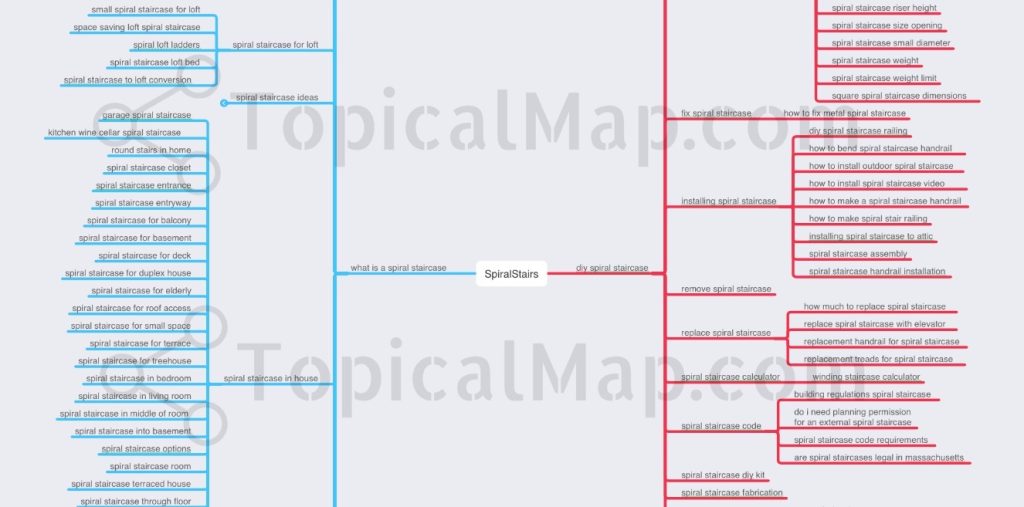This topical map sample is from a portion of a full topical map made for a spiral staircase manufacturer looking to expand its top-of-funnel (upper-funnel) content in the blog and resources section of its website.
For background, top-of-funnel content (ToFu) is content that does not directly promote your product or service, but rather informs, educates, or solves problems related to the industry and non-branded products/services.
The sample contains 291 topics that can be used to potentially write articles on. That’s only a portion of the total number of topics discovered on spiral stairs.
These are not the spiral staircase product pages that customers would go to when purchasing a spiral staircase from the manufacturer.
Adding ToFu content to a product manufacturer’s site will help them drive organic traffic, while also building brand awareness. The manufacturer will build topical authority in the staircase industry as the most knowledgeable manufacturer. When it comes time for a past visitor to purchase or build their own spiral staircase, the manufacturer will be top-of-mind.
So what’s in a topical map delivery?
When purchasing a topical map from us, you will receive 3 documents in your delivery:
- Spreadsheet
- Mind map
- How to Use Topical Map and Internal Linking Guide
In the spreadsheet, topic clusters are separated and nested hierarchically up to 4 levels (four separate columns) along with corresponding keywords.
In the mind map, the same topic clusters from the spreadsheet are visually laid out for easy viewing. It also helps to visually
The guide will explain how to read your specific spreadsheet and mind map. It’s tailored to your topical map. The document will also explain how to internally link your articles to ensure that Google and other search engine bots will easily understand your site structure.
A good site structure will also give your visitors a good user experience. Navigating your site will be a breeze for them.
Topical Map Example – Spreadsheet

The topical map spreadsheet delivered to you can act as the start of your content plan. The first 3 columns (URL, Position, Status) are there for your convenience to manage the articles that are being written and/or published and ranking already.
Below is what you will get with each plan. Do note that the number of topic clusters is not affected by the plan you order. You will receive the same topic clusters and keywords in all 3 packages.
Each topic cluster will also be checked against other topic clusters to ensure that there are no overlapping topics. Keyword clustering tools only go so far. You still need a person to check the clusters or you will run into keyword cannibalization and duplicate content issues on your site.
Starter Package
- Topic Clusters are nested up to 4 levels deep hierarchically – Main Topic 1, Subtopic 2, Subtopic 3, and Subtopic 4
- Keywords in each cluster
- Search Volume
- CPC (Cost per Click)
- Internal Linking Guide including how to find and use anchor text.
Authority Package
- Topic Clusters are nested up to 4 levels deep hierarchically – Main Topic 1, Subtopic 2, Subtopic 3, and Subtopic 4
- Keywords in each cluster
- Search Volume
- CPC (Cost per Click)
- Internal Linking Guide including how to find and use anchor text.
- SERP Keyword Difficulty – a manual, expert analysis of each topic’s difficulty in the SERPs. Separated into 5 levels of difficulty.
- Search Intent – a manual, expert analysis of each topic’s search intent.
- Content Type – suggestion for the type of content to create for the topic based on the SERPs and search intent.
- SEO Title – SEO-optimized suggestion for the article to write.
Topical Map Example – Mind Map

The mind map delivered will visually display up to 4 levels of topics that extend out from the base domain. The mind map file will be given as a file you can manipulate and as a PDF.
The topics listed will match the spreadsheet, so you can copy a topic and do a Find in the mind map for easy searching.
How is Topical Hierarchy Established?
A site’s topical hierarchy is one of the most important factors when it comes to creating topical maps and establishing topical authority. It guides Googlebot, search engines, and site visitors on whether or not your site should be considered a topical authority in the space.
The topical hierarchy of the main topics and sub-topics is done manually by an expert through research and understanding of the overall topic and industry.
There is no automated/AI tool that will be able to do this work. Some will try to do it semantically and keyword distance, but there is nothing that is close to the work that is done by manual research of the topic and understanding how all the topic clusters are related to each other.
If you’re interested in seeing the topical map samples, feel free to check out a PDF of the mind map and the related Google Sheet.
One note, this is only a portion of the topical map. There are 291 topics in this portion. The full topical map contains many more categories and topics.
If you have any more questions, do see the Topical Maps FAQs section.